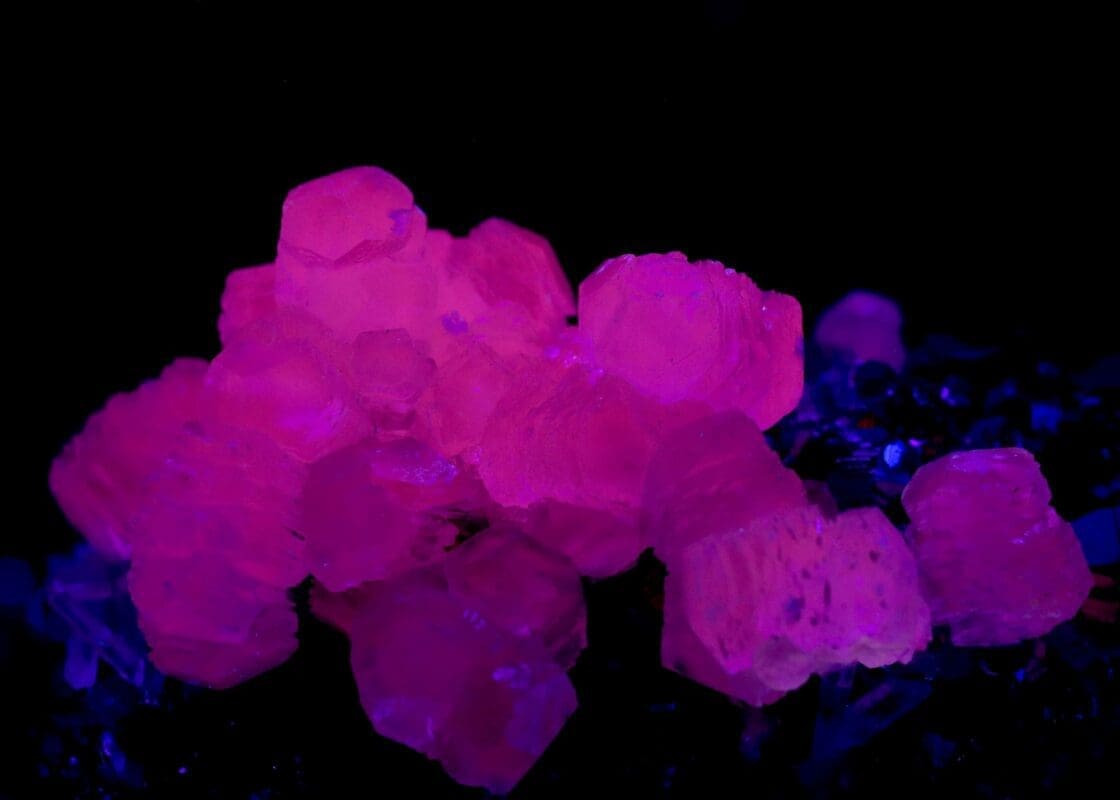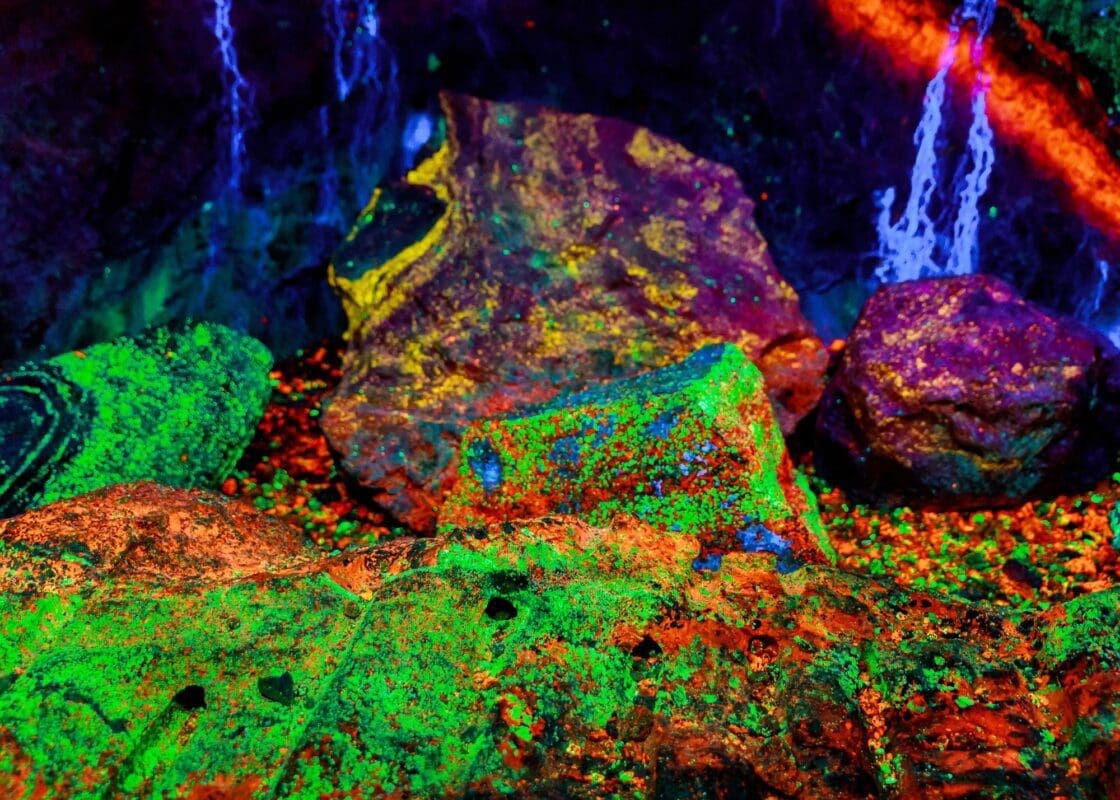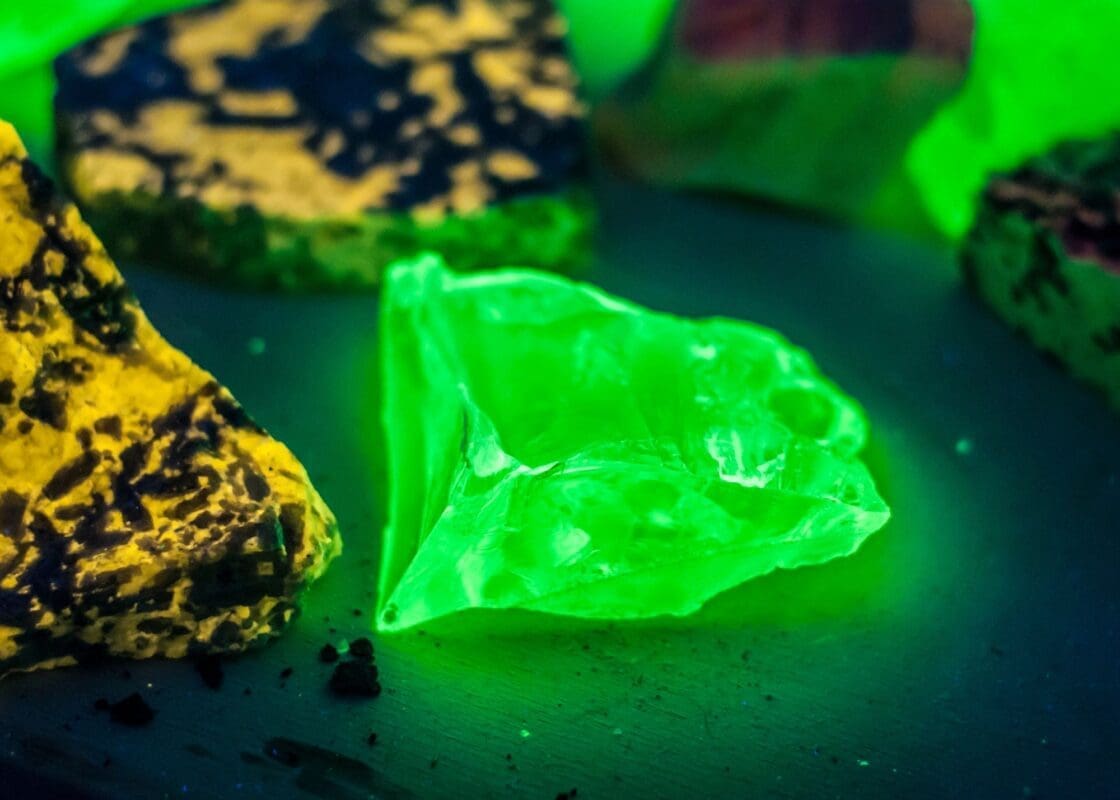Introduction
In the enigmatic world of minerals and gemstones, there exists a captivating phenomenon known as fluorescence. This article aims to unravel the mysteries surrounding fluorescent minerals, offering readers an in-depth exploration of their occurrence, identification, and the science that underpins this mesmerizing spectacle of nature. From the common quartz to the rare and exotic minerals that light up under specific conditions, we embark on a journey to illuminate the dark and reveal the hidden beauty of the Earth’s treasures.
Fluorescence in minerals and gemstones is a phenomenon where certain materials emit visible light when exposed to ultraviolet (UV) light. This occurrence is not just a visual spectacle but also a subject of scientific study, revealing insights into the composition and properties of the minerals. The applications of fluorescent minerals extend to geology, gemology, and even art, where their radiant glow is both studied and celebrated.
Understanding Fluorescence in Minerals
What mineral is fluorescent?
Fluorescent minerals are a diverse group, with some of the most common being calcite, fluorite, and aragonite. These minerals, when exposed to UV light, emit a glow that is often vibrant and can range in color depending on the mineral’s composition and the wavelength of UV light applied.
How do you know if a mineral is fluorescent?
Identifying a fluorescent mineral involves a series of tests and observations. One common method is exposing the mineral to UV light in a dark setting and observing if it emits visible light. The color and intensity of the light can offer clues to the mineral’s identity and composition.
What happens if you rub two quartz together?
An intriguing aspect related to fluorescence is triboluminescence. When two quartz crystals are rubbed together, they can produce a flash of light caused by the breaking of chemical bonds and the release of energy as light. This phenomenon, although not fluorescence, shares the captivating visual display of light emission from minerals.
The Science Behind Fluorescence
What minerals are fluorescent in UV light?
A variety of minerals respond to UV light, including calcite, which often glows red or orange, and willemite, known for its green fluorescence. The interaction between UV light and the mineral’s atoms causes electrons to jump to a higher energy state, releasing light as they return to their original state.
Why is my diamond blue under UV?
Diamonds can exhibit a blue fluorescence under UV light due to the presence of trace amounts of boron within their structure. This characteristic is not only mesmerizing but also practical, as it aids in the identification and grading of diamonds in the gemological field.
What does it mean if a diamond is blue under UV light?
A blue fluorescence in diamonds can impact their appearance and value. While some believe it adds to the diamond’s beauty, giving it a mystical glow, others argue it can make the diamond appear hazy or oily. The perception of the value added or detracted by fluorescence varies among jewelers and collectors.
A Closer Look at Fluorescent Minerals
What are three minerals that glow?
Calcite, fluorite, and willemite are notable for their distinct and vibrant glow under UV light. Each mineral exhibits a characteristic color, such as red for calcite, green for willemite, and a range of colors for fluorite, making them subjects of fascination for collectors and scientists alike.
What rocks glow in fluorescent light?
Rocks containing minerals like calcite, fluorite, or willemite can exhibit a notable glow under fluorescent light. The Franklin mine in New Jersey, for instance, is renowned for its vast variety of fluorescent minerals embedded within the rocks, offering a dazzling display of colors under UV light.
Which mineral has a smell of rotten eggs?
Sulfur, a mineral known for its yellow crystals, emits a distinct smell of rotten eggs when broken or scratched. Although not directly related to fluorescence, the characteristic odor of sulfur is another example of the fascinating sensory characteristics exhibited by certain minerals.
As we delve deeper into the subsequent sections, readers will gain insights into the rare and unique fluorescent minerals, the colors they exhibit, and practical tips for finding and identifying these radiant gems of the Earth. Each mineral, with its distinct glow, tells a story of the geological processes and conditions that birthed it, inviting us to a visual spectacle where science and art converge.
Fluorescent Gemstones
What are fluorescent gemstones?
Fluorescent gemstones are a category of gems that exhibit the mesmerizing ability to glow under ultraviolet (UV) light. This fluorescence is attributed to the presence of certain elements or impurities within the gemstones, which absorb UV light and re-emit it as visible light. The glow can range from subtle to vivid, casting these precious stones in an ethereal light that has fascinated jewelers, collectors, and enthusiasts for centuries.
Do diamonds glow under UV light?
Diamonds, one of the most coveted gemstones, can indeed exhibit fluorescence under UV light. This phenomenon is primarily due to the presence of nitrogen, boron, or other trace elements within the diamond’s structure. While some diamonds emit a blue glow, others can fluoresce in a range of colors, adding a layer of complexity and allure to the gem’s valuation and appeal. The intensity and color of the fluorescence can influence the diamond’s appearance, sometimes enhancing its whiteness and at other times, affecting its clarity.
Do rubies fluoresce under UV light?
Rubies, with their iconic red hue, can also exhibit fluorescence. The presence of chromium ions in rubies is responsible for both their red color and their ability to fluoresce. Under UV light, rubies can emit a red to orange glow, enhancing their color intensity and making them appear more vibrant. This attribute is often sought after, as it adds to the gemstone’s visual appeal and value.
Do sapphires fluoresce?
Sapphires, another member of the corundum family like rubies, can also fluoresce, although it is less common. When they do, it’s often due to the presence of trace elements like iron or titanium. The fluorescence in sapphires is typically blue or green and can vary in intensity. It adds an additional factor for gemologists and collectors to consider when evaluating the quality and value of the stone.
Rare and Unique Fluorescent Minerals
What rare minerals are fluorescent?
Beyond the well-known fluorescent minerals, there exists a realm of rare and unique minerals that also exhibit this captivating phenomenon. Minerals like benitoite, which fluoresces a brilliant blue under UV light, and painite, considered one of the rarest minerals on Earth, can also exhibit fluorescence, adding to their mystique and value.
What is the rarest mineral on Earth?
Painite holds the title as one of the rarest minerals on Earth. Its fluorescence is a lesser-known characteristic, overshadowed by its rarity. When subjected to UV light, painite can emit a gentle glow, a feature that adds another layer of intrigue to this already enigmatic mineral.
Are there any glowing stones?
Certain stones, like hackmanite, exhibit a natural glow, a phenomenon known as tenebrescence. These stones can change color and intensity when exposed to sunlight or UV light, offering a dynamic and ever-changing visual display that captivates collectors and enthusiasts.
Colors of Fluorescence
What minerals fluoresce green?
Green fluorescence is often associated with minerals like willemite and hyalite opal. Willemite, found in locations like the Franklin Mine in New Jersey, is renowned for its vibrant green glow under UV light. Hyalite opal, on the other hand, offers a softer, ethereal green glow, reminiscent of a moonlit night.
What stones fluoresce blue?
Blue fluorescence is commonly associated with gemstones like diamonds and minerals like benitoite. The trace elements and impurities within these stones absorb UV light and re-emit it as a blue glow, adding to their visual appeal and mystique.
What glows yellow under black light?
Yellow fluorescence can be observed in minerals like scheelite and esperite. Scheelite, known for its utility in ore mining, emits a bright yellow glow under black light, aiding in its identification. Esperite, with its yellow to green fluorescence, adds a visual spectacle to the world of fluorescent minerals.
Each color of fluorescence tells a story of the mineral’s composition, the geological processes that formed it, and the elements that came together to create this visual spectacle. As we delve deeper into the world of fluorescent minerals and gemstones, we uncover a radiant tapestry of nature’s artistry, where each glow and hue is a testament to the Earth’s enigmatic beauty.
Special Cases and Considerations
Is there a mineral that glows in the dark?
While fluorescence is a common topic of discussion, phosphorescence is a related yet distinct phenomenon that deserves attention. Phosphorescent minerals, such as calcite and zinc sulfide, have the unique ability to glow in the dark after exposure to light. This lingering glow results from a slow release of energy absorbed, offering a mystical and prolonged display of light that can last for several minutes or even hours after the light source is removed.
What rock naturally glows?
Certain rocks, enriched with minerals like autunite or uraninite, exhibit a natural glow. Autunite, a uranium mineral, is renowned for its yellow-green fluorescence and phosphorescence. It’s a striking example of rocks that not only glow under UV light but also exhibit phosphorescence, illuminating the dark with their eerie, otherworldly glow.
What stone naturally glows in the dark?
Hackmanite is a notable example of stones that exhibit tenebrescence, a phenomenon where the stone changes color when exposed to sunlight and glows in the dark. This captivating attribute makes hackmanite and similar stones a subject of fascination, bridging the worlds of gemology, mineralogy, and art.
Finding and Identifying Fluorescent Minerals
What are the best ways to find fluorescent minerals?
Finding fluorescent minerals can be an adventurous pursuit. Explorers often arm themselves with UV lamps and venture into known mineral-rich regions, mines, and caves. The use of shortwave and longwave UV lights can reveal the hidden glow of minerals, turning an ordinary rock-hunting expedition into a luminous treasure hunt.
Does quartz fluoresce?
Quartz, one of the most abundant minerals on Earth, can sometimes exhibit fluorescence. Though not as common as in minerals like calcite or fluorite, fluorescent quartz is a prized find. The fluorescence is often due to impurities or defects in the crystal structure, and it can range in color, offering collectors a subtle yet enchanting visual display.
Does lapis lazuli fluoresce?
Lapis lazuli, with its deep celestial blue, can also fluoresce. The sodalite component of lapis lazuli is often responsible for its orange to red fluorescence under UV light. This attribute adds another layer of aesthetic and mystical appeal to this already revered stone.
Does cubic zirconia fluoresce?
Cubic zirconia, a popular diamond simulant, can exhibit fluorescence. Under UV light, it often emits a yellow, green, or orange glow, a characteristic that can sometimes be used to distinguish it from natural diamonds, adding a practical aspect to the visual spectacle of fluorescence.
Does tourmaline glow under UV light?
Tourmaline, known for its rich spectrum of colors, can also fluoresce. The presence of manganese often contributes to its fluorescence, casting the stone in a soft, radiant glow that accentuates its natural beauty.
Does amethyst fluoresce?
Amethyst, the purple variety of quartz, can exhibit fluorescence. The intensity and color of the glow can vary, often influenced by the presence of iron or other trace elements. This fluorescence adds a mystical aura to amethyst’s already enchanting purple hue.
Do opals glow under UV light?
Opals are renowned for their play-of-color, but some varieties also fluoresce under UV light. The fluorescence can range from green to yellow, adding another dimension to the opal’s visual appeal.
Do emeralds fluoresce?
Emeralds, with their iconic green hue, can exhibit red fluorescence under UV light due to the presence of chromium. This red glow adds a contrasting and captivating visual element to the emerald’s appearance.
What precious stone glows in the dark?
Certain precious stones like diamonds can exhibit phosphorescence, continuing to glow after the UV light is removed. This afterglow is a captivating feature that adds to the mystery and allure of these precious gems.
Conclusion
As we draw this illuminating journey to a close, the radiant world of fluorescent minerals and gemstones stands unveiled in all its luminous splendor. Each glowing mineral and gemstone, from the common quartz to the rare painite, tells a tale of Earth’s intricate geological ballet, where elements, pressure, and time dance together to birth these radiant treasures.
The beauty and mystery of fluorescent minerals and gemstones lie not just in their ability to cast light in the dark recesses of the Earth but also in the stories they tell of our planet’s dynamic and enigmatic nature. We invite readers to step into this radiant world, armed with the knowledge and curiosity to explore, discover, and marvel at the luminous gems that lie hidden yet resplendent, in the heart of the Earth.






















